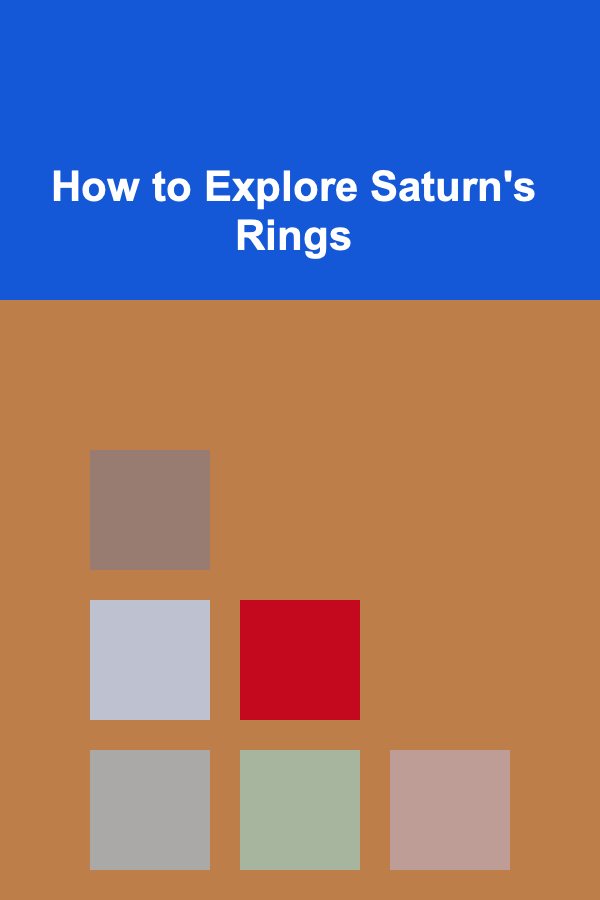
How to Explore Saturn's Rings
ebook include PDF & Audio bundle (Micro Guide)
$12.99$8.99
Limited Time Offer! Order within the next:

Saturn's rings, one of the most spectacular and enigmatic features in our solar system, have fascinated astronomers, scientists, and space enthusiasts for centuries. They are not just a beautiful sight from Earth; they hold crucial clues about the formation of planets, moons, and the broader processes governing the evolution of the solar system. Exploring Saturn's rings is a challenge that requires cutting-edge technology, advanced scientific understanding, and, above all, curiosity. In this article, we will delve into the methods, scientific objectives, and the technology behind the exploration of Saturn's rings.
Understanding Saturn's Rings
Saturn's rings are composed primarily of ice particles, dust, and rocky debris. They extend from about 6,000 kilometers to nearly 120,000 kilometers from Saturn's surface, but they are incredibly thin---roughly 10 meters thick in most places. There are seven main rings, named A, B, C, D, E, F, and G, with the A, B, and C rings being the most prominent. The material that composes these rings varies in size, from microscopic grains to boulders several meters in diameter. These rings are believed to have formed billions of years ago, and their exact origin remains a subject of intense scientific debate.
Understanding Saturn's rings is critical because they provide insights into the history of the planet and its moons. By analyzing the rings, scientists can infer the dynamics of Saturn's environment, including the interactions between the planet's gravity and its satellites, the physics of ring formation, and the processes of material accretion and collision.
The Challenges of Exploring Saturn's Rings
Exploring Saturn's rings presents a series of unique challenges. For one, the vast size of the rings makes it difficult to study them from a distance. Their thinness means that traditional observation methods, such as optical telescopes, provide limited data. The particles within the rings can also be dangerous to spacecraft, as even small grains of ice traveling at high velocities can cause significant damage. Additionally, Saturn is located over a billion kilometers from Earth, making missions to the planet and its rings long and costly endeavors.
The environment around Saturn also adds complexity to the exploration process. The planet's magnetosphere, a powerful magnetic field that surrounds it, can interfere with spacecraft electronics and instrumentation. Spacecraft must be specially designed to withstand these conditions, requiring robust engineering and precise mission planning.
Space Missions to Explore Saturn's Rings
Several missions have been launched to explore Saturn, and each has brought us closer to understanding the planet and its rings. The most significant of these is NASA's Cassini mission, which orbited Saturn from 2004 until 2017. Cassini's journey through the ring system provided unprecedented details about the planet, its moons, and the structure of the rings. Let's explore some key missions that have contributed to the exploration of Saturn's rings.
The Pioneer and Voyager Missions
NASA's Pioneer 10 and Pioneer 11 were the first spacecraft to fly past Saturn. Pioneer 10, launched in 1972, made history as the first spacecraft to cross the orbit of Saturn in 1979. Pioneer 11 followed shortly after, making its flyby of Saturn in 1979. Though these early missions provided some data about Saturn and its rings, they were limited by the technology of the time and their relatively short encounters with the planet.
The Voyager 1 and Voyager 2 missions, launched in 1977, provided much more detailed observations of Saturn and its rings. Voyager 1's flyby in 1980 and Voyager 2's in 1981 marked significant milestones in the exploration of the outer solar system. Both spacecraft took detailed photographs of Saturn's rings and discovered several new moons and ring features. The data gathered by Voyager helped scientists understand the composition and structure of the rings, as well as the dynamics of the planet's system.
The Cassini-Huygens Mission
The most detailed exploration of Saturn's rings came from NASA's Cassini-Huygens mission, a collaborative effort between NASA, the European Space Agency (ESA), and the Italian Space Agency (ASI). Launched in 1997, Cassini entered orbit around Saturn in 2004, where it spent 13 years studying the planet, its moons, and its rings in incredible detail.
Cassini performed multiple flybys of Saturn's rings, collecting data with instruments such as the Cosmic Dust Analyzer (CDA), the Imaging Science Subsystem (ISS), and the Ultraviolet Imaging Spectrometer (UVIS). These instruments provided detailed information about the composition, structure, and behavior of the rings. Cassini also performed a series of "Grand Finale" orbits in 2017, where it passed between Saturn's innermost rings and the planet itself, gathering valuable data about the planet's atmosphere, gravity, and ring dynamics before its mission ended in September 2017.
One of the most important discoveries made by Cassini was the detection of water plumes erupting from the moon Enceladus, which may be linked to the composition of Saturn's rings. Cassini also observed interactions between the rings and Saturn's moons, uncovering complex patterns in the ring's structure that suggest ongoing processes of accretion and erosion.
The Dragonfly Mission
While the Cassini mission provided a wealth of data about Saturn's rings, the Dragonfly mission, scheduled for launch in 2027, will focus on Titan, one of Saturn's moons. Titan, with its thick atmosphere and methane lakes, is considered one of the most intriguing bodies in the solar system. While Dragonfly will not directly study Saturn's rings, it will explore the environment of Titan, providing a better understanding of the broader Saturnian system. Titan's interaction with Saturn's rings could offer additional insights into the evolution of the ring system.
The Technology Behind Exploring Saturn's Rings
Exploring Saturn's rings requires specialized technology designed to withstand the harsh environment of the outer solar system. Spacecraft that venture to Saturn must be equipped with sophisticated instruments capable of gathering data from afar and analyzing the complex dynamics of the rings.
Imaging Systems
The Cassini spacecraft was equipped with a variety of imaging systems that allowed scientists to capture high-resolution images of Saturn's rings. The Imaging Science Subsystem (ISS) on Cassini was one of the most powerful instruments, providing detailed photographs of the rings from various angles. These images were essential in mapping the structure of the rings and detecting changes over time.
Other imaging technologies, such as ultraviolet and infrared cameras, allowed for a deeper analysis of the composition and temperature of the rings. Infrared imaging, in particular, revealed differences in the temperatures of different parts of the rings, indicating areas of greater density and activity.
Dust Analyzers and Spectrometers
To understand the composition of the rings, spacecraft like Cassini used dust analyzers such as the Cosmic Dust Analyzer (CDA). These instruments are designed to capture individual particles from the ring system, analyzing their size, speed, and composition. By measuring the dust in Saturn's rings, scientists can infer the chemical makeup of the rings and learn about the processes that govern their formation and evolution.
Spectrometers on Cassini and other missions were used to analyze the light reflected by the rings. By studying the spectra of the rings, scientists can determine the presence of different elements, compounds, and materials, further improving our understanding of the rings' composition.
Gravity and Magnetometry
Saturn's immense gravitational field and magnetosphere also play a crucial role in the behavior of the rings. Instruments such as Cassini's Gravity Science and Magnetometer help scientists study how Saturn's gravity influences the dynamics of the rings. These tools measure the gravitational pull of Saturn on the spacecraft, providing important data about the distribution of mass within the rings and the planet's interior. The magnetometer also tracks Saturn's magnetic field, helping scientists understand how the planet's magnetic environment interacts with the particles in the rings.
Entry and Exit Strategies
Exploring Saturn's rings requires careful maneuvering. Spacecraft must avoid getting too close to the rings to prevent damage from high-velocity particles. However, in Cassini's case, the spacecraft was able to safely navigate between Saturn's rings in its Grand Finale orbits, gathering critical data while avoiding the dangers of direct contact. For future missions, similar strategies will be employed, with spacecraft entering orbits that minimize risks while maximizing data collection.
Future of Saturn's Ring Exploration
With the success of the Cassini mission, Saturn's rings have been studied more extensively than ever before. However, there is still much to learn about these stunning structures. Future missions, both to Saturn and its moons, will likely continue to provide valuable insights into the nature of the rings, their formation, and their relationship to the larger Saturnian system.
Advancements in technology, such as more advanced imaging systems, dust analyzers, and artificial intelligence, could provide even more detailed data on Saturn's rings in the future. Additionally, new scientific theories about the origins of Saturn's rings may emerge as more data is collected, leading to a deeper understanding of how planets and their systems evolve.
Exploration of Saturn's rings will continue to fuel our curiosity and expand our knowledge of the solar system. As we look to the future, it is clear that the study of these majestic rings is far from over. Their complexity and beauty will continue to inspire scientists and space enthusiasts alike as we work to unravel the mysteries they hold.

How To Get Paid Internationally
Read More
How to Perform Regular Electrical Inspections to Prevent Hazards
Read More
How to Prepare for a Job Fair: Strategies for Success
Read More
How to Sell Handmade Knitted Items on Etsy: A Comprehensive Guide
Read More
The Biomedical Engineer's Guide: Innovating Healthcare Through Technology
Read More
How To Find Free Entertainment and Activities
Read MoreOther Products

How To Get Paid Internationally
Read More
How to Perform Regular Electrical Inspections to Prevent Hazards
Read More
How to Prepare for a Job Fair: Strategies for Success
Read More
How to Sell Handmade Knitted Items on Etsy: A Comprehensive Guide
Read More
The Biomedical Engineer's Guide: Innovating Healthcare Through Technology
Read More